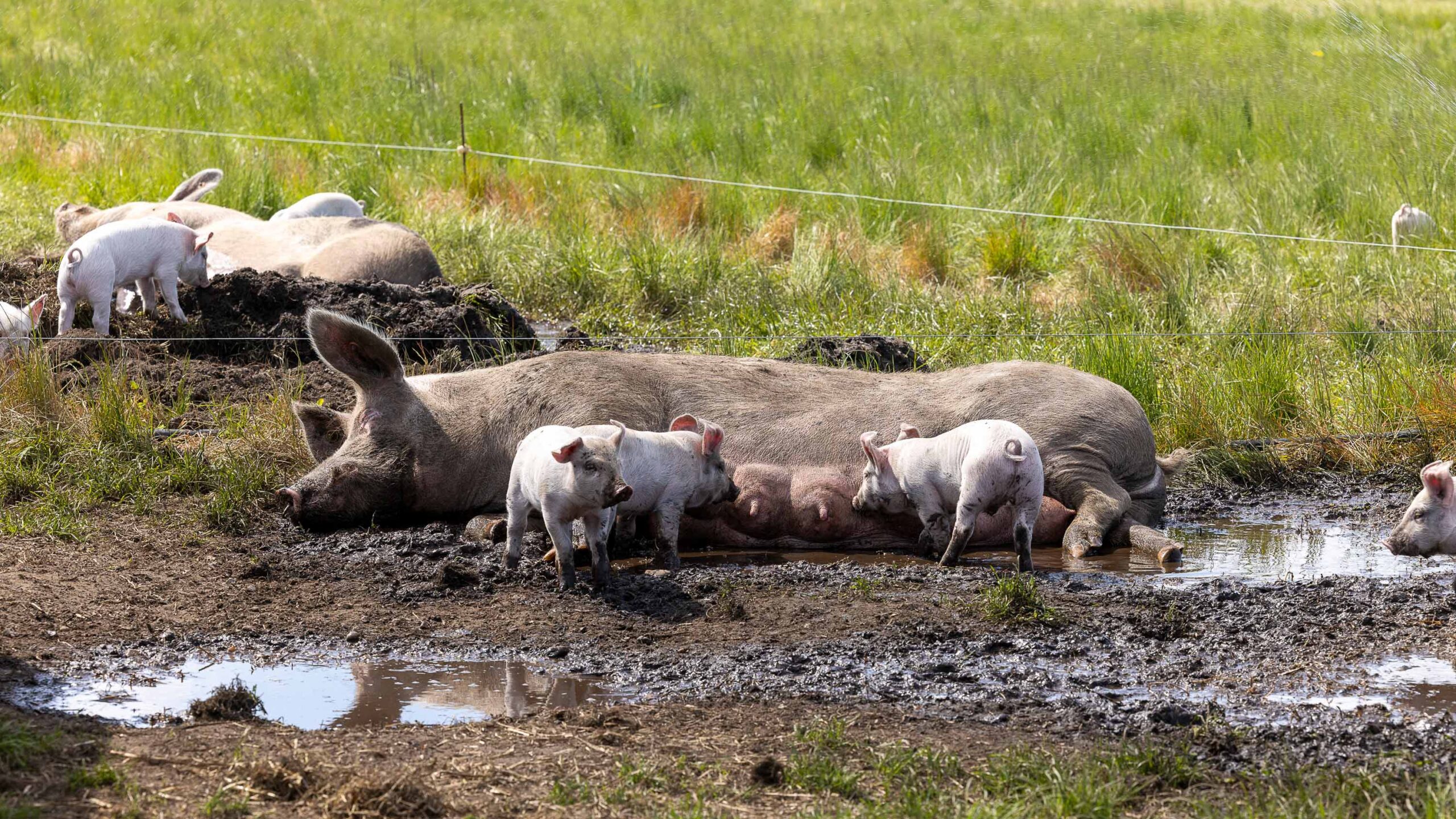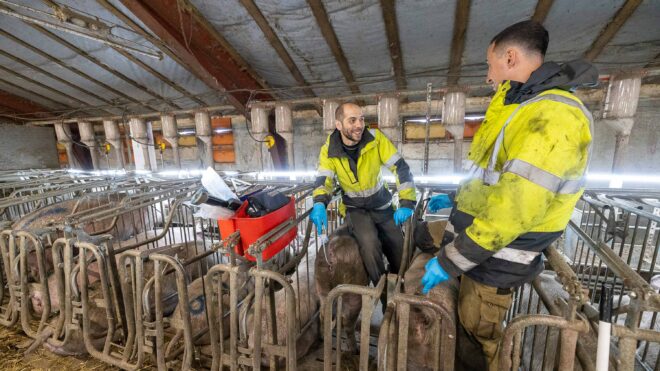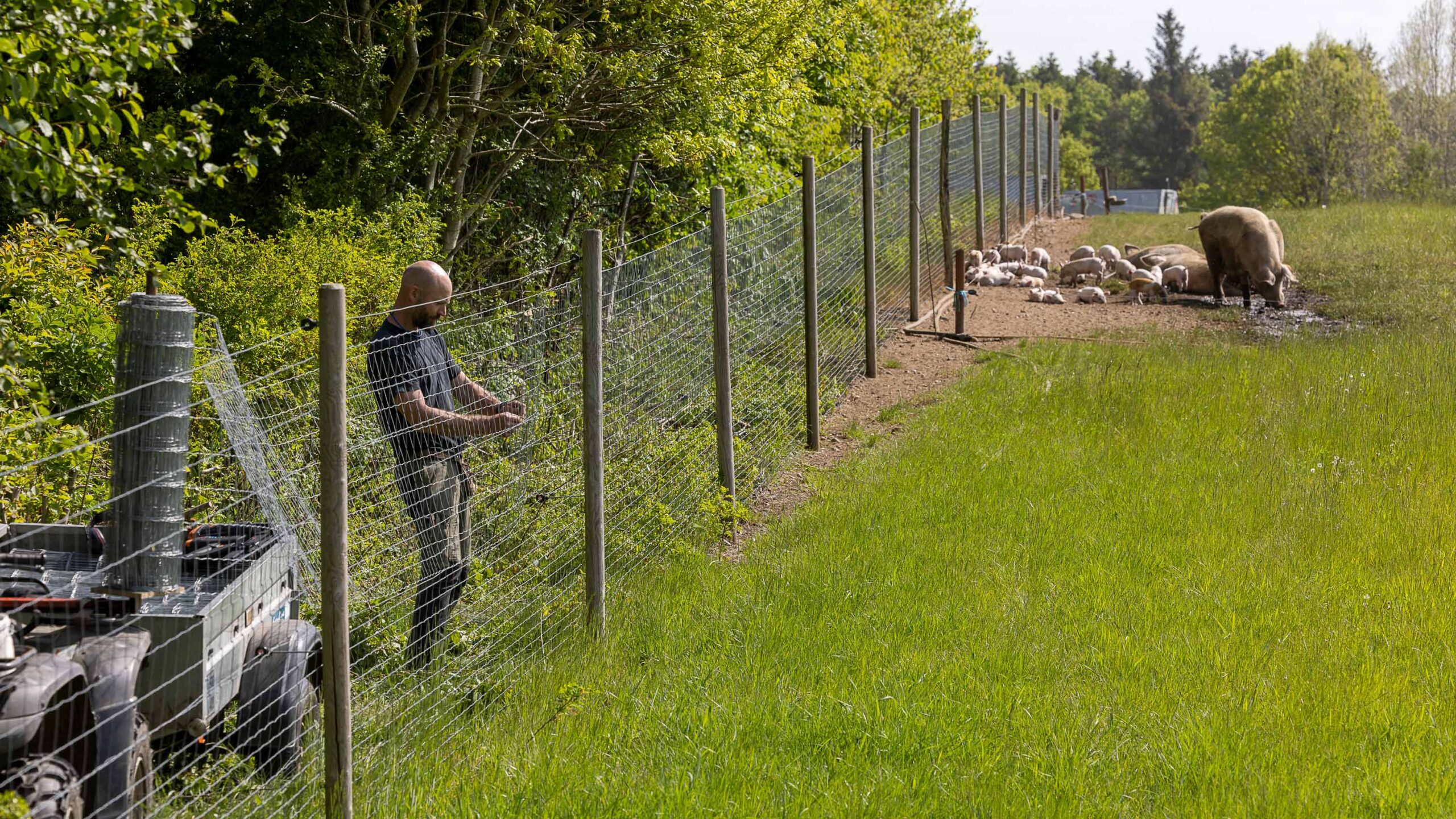The sows at Greensgaard, near Give, have masses of space – each having the equivalent of a medium-sized Danish detached house. The 1,050 sows are raised by Peter Bruun and Lene Conradsen, who supply their entire annual production of 29,000 pigs to the retail chain Rema 1000 under the brand ‘Frilandsgrise fra Peter og Lene’ (Free-range pigs from Peter and Lene).
When they began their collaboration with the retail chain in 2018, the agreement was based on the delivery of 330 pigs per week. Although they were producing 360, the store chain was hesitant to purchase that quantity. However, the free-range meat was popular with customers and over the past seven years the couple has nearly doubled the number of sows. In 2022, Rema 1000 brought in a new producer to meet growing demand.
I feel happy every day when I walk among the pigs and see they are content and in good health.
Lene Conradsen
For now, it’s Peter and Lene who have capped the deliveries to the store. Greensgaard Farm is of a size that suits them, balancing economy, animal welfare, working practices, employees, animals, and land. So further growth is not immediately on the agenda.
Three-pronged collaboration
The large kitchen area at Greensgaard is cleared of employees following the morning’s combined coffee break, discussion of the day’s work, and addressing various questions and issues. There is homemade cake on the table – something that occurs frequently. On the wall hangs a large board listing each of the approximately 20 employees’ names and tasks, so everyone knows where each person is and when. If anyone is unsure, both Lene and Peter are ready to provide clarification before the individual leaves for their tasks.

From the start, ‘Free-range pigs from Peter and Lene’ has been based on a three-pronged partnership includingslaughter company Tamacoand Rema 1000, which has committed to purchasing the entire pig, ensuring the meat remains within a Danish cycle. Each partner has a distinct role. Or, as Peter expresses it: “Our knowledge of pigs ends when the pig walks up the loading ramp.”
Similarly, the division of labour between the owners of Greensgaard is clear. Lene manages the outdoor life and long-term planning for the sows and piglets, while Peter is responsible for their indoor life, taking over when the piglets are five weeks old and moved to a spacious straw barn and associated outdoor area, to be fattened. “He is also responsible for the farm’s maintenance and pays the bills,” Lene adds with a laugh.
Employee loyalty through appreciation and trust
Inseminating 1,050 sows, castrating 15,000 young male pigs, fattening 29,000 finishers, and providing feed, water, and bedding for the entire herd – a significant portion of which roam freely on 90ha – requires many skilled hands and minds. And this in a profession that frequently has labour issues.

“We don’t recruit many employees because we keep them,” Lene states with confidence before elaborating: “We put a great deal of effort into the job interview process. We want to ensure they understand that everyone should thrive here, that we maintain a proper tone, co-operate together, and respect each other.”
The demands of the job do not intimidate the staff, many of whom are Danish; several have years of experience at Greensgaard. Some have even been here for 10 or 20 years, adds Peter, who emphasises that work should be enjoyable and even fun. Part of employee care includes group gymnastics every Wednesday, during work hours, with pay.
Precise processes for healthy animals
Industry is often associated with assembly lines, where employees repeat the same three functions while the product rolls by. But nothing could be further from working at Greensgaard – although with so many animals, each with different needs at different times, assembly line logistics are a benefit. But here, it’s the staff that make up the moving part, not the pigs.
Take castration, for example: During the first five to seven days of life, the piglets remain in the sow hut, where the procedure takes place. The sow is lured out of the hut with feed. The employee checks the sex of the piglet, administers anaesthesia, performs castration, gives a pain relief injection, and returns the piglet to the herd. It’s a short procedure, but one that extends over three days a week.


During insemination, the approach is reversed. In the past, sows were inseminated in the field, but sun, wind, and weather can cause the heat cycle to fluctuate slightly from sow to sow, so not all were in heat when it was time to inseminate. Not even the scent of a fragrant boar could synchronise them. “So now, instead, we take the sows in question to the barn for four to six days, during which they come into heat, are inseminated, and then released back into the field,” explains Peter.
Pig life under the open sky
Except for insemination, the sows spend their entire lives outdoors. Farrowing occurs in pig huts throughout the year, and regardless of the weather, the piglets remain with the sow until weaning. “The pigs thrive in the winter weather,” says Lene. “Except that we often run around with headlamp torches,” she adds with a smile. “Summer requires much more work. We need much more water, because we have to create mud pits for the pigs to bathe in. The mud protects the pigs from sunburn so it has to be just right.

One of the tasks associated with free-range production is the installation and maintenance of fences. At Greensgaard, the field is surrounded by seven kilometres of fencing, designed to prevent foxes from jumping over or digging in to reach the piglets. However, gulls, ravens, and rooks still pose a threat. “We try to keep them away using various deterrents, but we are only allowed to shoot a very small number, so the population is increasing,” states Peter.
Since the start in 2003, the couple have sworn by free-range pigs. Peter, a trained farmer, was inspired by methods observed in England and brought them with him when he established his farm after several years working as an educator and with the Danish Church Aid. Lene, who had originally aspired to become a veterinarian, agreed, drawn to the way free-range life mirrors the pigs’ natural behaviour. “I feel happy every day when I walk among the animals, seeing that they are well and content,” she says.
Animal welfare without an organic label
It might seem natural for the couple to take the next step and operate Greensgaard as an organic free-range farm. But while they have considered they idea, they have rejected it. They openly admit that they are not ecologists at heart. What they are, however, is free-range enthusiasts, where the welfare and well-being of the animals is paramount. They appreciate the way animals are kept and commend sensible farming, where not a gram of fertiliser or pesticides is used more than necessary. When it comes to environmental impact and piglet mortality, which are common objections to free-range farming, Greensgaard performs just as well or even better than both conventional and organic farms.

Each year, the sows are moved to new pastures, and the old field is drilled with crops that absorb the nutrients from the pigs’ manure. Straw and feed residues from pastures are sent along with manure and bedding to a biogas facility. In 2022, piglet mortality (including stillbirths and deaths in the farrowing house) was 23% in conventional farms and 30% in organic farms. At Greensgaard, it was only 18%. However, the low number has a harsh background: Over the years, the pigs had contracted several diseases and eventually also the lung disease APP2. After implementing various measures, the couple decided to cull the entire herd in 2022/23. It was an expensive story that cost them 4m kroner (£460,600).
About Greensgaard
- Feed is purchased
- 1,050 free-range sows. Slaughtered after three years
- 29,000 finished pigs slaughtered annually
- Approximately 20 employees, equivalent to 17-18 full-time
- A total of 420ha, partially leased
- Annual straw consumption: 1.7-2m kg of straw, own production
“On that occasion, we switched to sows from Topigs Norsvin,” says Peter. “They have two additional teats and produce an average of four fewer piglets per litter. The advantage is that this means that the piglets are larger and more robust. We avoid the stress with nursing sows and have a low mortality rate among piglets. Luckily, the bank said yes.”
